 W
WA mountain man is an explorer who lives in the wilderness. Mountain men were most common in the North American Rocky Mountains from about 1810 through to the 1880s. They were instrumental in opening up the various Emigrant Trails allowing Americans in the east to settle the new territories of the far west by organized wagon trains traveling over roads explored and in many cases, physically improved by the mountain men and the big fur companies originally to serve the mule train based inland fur trade.
 W
WThe Hawken rifle is a muzzle-loading rifle built by the Hawken brothers that was used on the prairies and in the Rocky Mountains of the United States during the early frontier days. It has become synonymous with the "plains rifle", the buffalo gun, and the fur trapper's gun. Developed in the 1820s, it was eventually displaced by breechloaders and lever-action rifles which flourished after the Civil War.
 W
WJohn "Grizzly" Adams (1812–1860) was a famous California mountain man and trainer of grizzly bears and other wild animals he captured for menageries, zoological gardens and circuses.
 W
WJohn David Albert was an American mountain man.
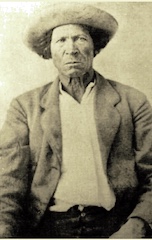 W
WCharles Autobees (1812–1882), whose last name was also spelled Urtebise and Ortivis, was a fur trader and pioneer in the American Old West. He was the founder of Autobees, Colorado.
 W
WJames Pierson Beckwourth, born James Beckwith and generally known as Jim Beckwourth, was an American mountain man, fur trader, and explorer. Beckwourth was also famously known as "Bloody Arm" because of his skill as a fighter. He was mixed-race and born into slavery in Virginia. He was freed by his white father, and apprenticed to a blacksmith so that he could learn a trade.
 W
WBenjamin Louis Eulalie de Bonneville was an American officer in the United States Army, fur trapper, and explorer in the American West. He is noted for his expeditions to the Oregon Country and the Great Basin, and in particular for blazing portions of the Oregon Trail.
 W
WDaniel Boone was an American pioneer, explorer, woodsman, and frontiersman whose frontier exploits made him one of the first folk heroes of the United States. Although he also became a businessman, soldier and politician who represented three different counties in the Virginia General Assembly following the American Revolutionary War, Boone is most famous for his exploration and settlement of what is now Kentucky. Although on the western side of the Appalachian Mountains from most European-American settlements, Kentucky remained part of Virginia until it became a state in 1792.
 W
WJames Felix Bridger was an American mountain man, trapper, Army scout, and wilderness guide who explored and trapped in the Western United States in the first half of the 19th century. He was from the Bridger family of Virginia, English immigrants that had been in North America since the early colonial period.
 W
WBuckskins are clothing, usually consisting of a jacket and leggings, made from buckskin, a soft sueded leather from the hide of deer. Buckskins are often trimmed with a fringe – originally a functional detail, to allow the garment to shed rain, and to dry faster when wet because the fringe acted as a series of wicks to disperse the water – or quills. They also served as a form of camouflage when hunting, by breaking up the outline of the wearer and allowing them to blend in with their background.
 W
WFor a list of other individuals by the same name, see Robert Campbell.
 W
WChristopher Houston Carson, better known as Kit Carson, was an American frontiersman. He was a fur trapper, wilderness guide, Indian agent, and U.S. Army officer. He became a frontier legend in his own lifetime by biographies and news articles, and exaggerated versions of his exploits were the subject of dime novels. His understated nature belied confirmed reports of his fearlessness, combat skills, tenacity, and profound effect on the westward expansion of the United States. Although he was famous for much of his life, historians in later years have written that Kit Carson did not like, want, or even fully understand the celebrity that he experienced during his life.
 W
WMansel Carter a.k.a. Man of the Mountain was a businessman and prospector. In 1987, Phoenix Magazine named him one of "Arizona Legends". The San Tan Historical Society of Queen Creek recognized his gravesite in the Gold Mountain of the San Tan Mountain Regional Park in Queen Creek, Arizona a tourist attraction. In 2017, the town of Queen Creek named a new community park the "Mansel Carter Oasis Park" in his honor.
 W
WJohn Colter was a member of the Lewis and Clark Expedition (1804–1806). Though party to one of the more famous expeditions in history, Colter is best remembered for explorations he made during the winter of 1807–1808, when he became the first known person of European descent to enter the region which later became Yellowstone National Park and to see the Teton Mountain Range. Colter spent months alone in the wilderness and is widely considered to be the first known mountain man.
 W
WA coonskin cap is a hat fashioned from the skin and fur of a raccoon. The original coonskin cap consisted of the entire skin of the raccoon including its head and tail. Beginning as traditional Native American headgear, coonskin caps became associated with American and Canadian frontiersmen of the 18th and 19th centuries, and were highly popular among boys in the United States, Canada, the United Kingdom and Australia in the 1950s.
 W
WAlexander Culbertson (1809–1879), was an American fur trader who founded Fort Benton, Montana, and was a special government agent who played an important role in the negotiations leading to the 1851 treaty of Fort Laramie. Later, Culbertson and his wife Natawista Iksina negotiated with the Blackfoot Confederacy to let the northern Pacific railroad survey of 1853 continue unharmed.
 W
WGeorge Wood "Squire" Ebbert (1810–1890) was a mountain man and early settler in the Oregon Country. Born in Kentucky, he settled on the Tualatin Plains in what would become Oregon and participated in the Champoeg Meetings that created a government prior to the formation of the Oregon Territory. During the Cayuse War he traveled with Joseph Meek across the Rocky Mountains to ask Congress for assistance with the war.
Mike Fink, called "king of the keelboaters", was a semi-legendary brawler and river boatman who exemplified the tough and hard-drinking men who ran keelboats up and down the Ohio and Mississippi Rivers.
 W
WThomas Fitzpatrick, known as "Broken Hand", was a famous Irish-American "mountain man", "friend of the Indians", trailblazer and trapper with the Rocky Mountain Fur Company. With Jedediah Smith, he led a trapper band that discovered South Pass, Wyoming; however, before that Robert Stuart led the first known white party through the South Pass.
 W
WHugh Glass was an American frontiersman, fur trapper, trader, hunter, and explorer. He is best known for his story of survival and forgiveness after being left for dead by companions when he was mauled by a grizzly bear.
 W
WWilliam Thomas Hamilton, also known as Wildcat Bill, was an American frontiersman and author of Scottish and English heritage.
 W
WLevi Boone Helm was a mountain man and gunfighter of the American West known as the Kentucky Cannibal. Helm was a serial killer who gained his nickname for his opportunistic and unrepentant proclivity for the consumption of human flesh taken from the bodies of enemies and traveling companions. While this was usually done in survival situations, Helm sometimes took flesh in preparation for a survival situation.
 W
WHenry Inman was an American soldier, frontiersman, and author. He served the military during the Indian campaigns and the American Civil War, having earned distinction for gallantry on the battlefield. He was commissioned lieutenant general during the Indian wars. He settled in Kansas and worked as a journalist and author of short stories and books of the plains and western frontier. He was a friend and associate of Buffalo Bill and served under General Custer.
 W
WJohn "Liver-Eating" Johnson, born John Jeremiah Garrison Johnston, was a mountain man of the American Old West.
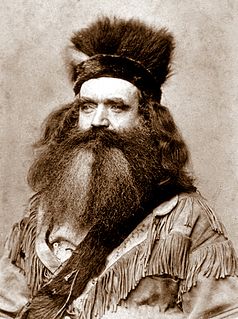 W
WSeth Kinman was an early settler of Humboldt County, California, a hunter based in Fort Humboldt, a famous chair maker, and a nationally recognized entertainer. He stood over 6 ft (1.83 m) tall and was known for his hunting prowess and his brutality toward bears and Indian warriors. Kinman claimed to have shot a total of over 800 grizzly bears, and, in a single month, over 50 elk. He was also a hotel keeper, saloon keeper, and a musician who performed for President Lincoln on a fiddle made from the skull of a mule.
 W
WJames Kirker (1793–1852) was an Irish-born American privateer, soldier, mercenary, merchant, Mountain man, and scalp hunter. He is best known for his contracts with the Mexican government to kill or capture Apache Indians.
 W
WJacques La Ramée, was a French-Canadian Métis coureur des bois, frontiersman, trapper, fur trader, hunter, explorer, and mountain man who lived in what is now the U.S. state of Wyoming, having settled there in 1815. His name appears in several spellings, including La Ramee, Laramée, LaRamée, La Ramie, La Rami, La Remy, and Laramie. La Ramée is credited as an early explorer of what is now called the Laramie River of Wyoming and Colorado. The city of Laramie, Wyoming, with an Americanized spelling, was later named for him.
 W
WManuel Lisa, also known as Manuel de Lisa, was a Spanish citizen and later, became an American citizen who, while living on the western frontier, became a land owner, merchant, fur trader, United States Indian agent, and explorer. Lisa was among the founders, in St. Louis, of the Missouri Fur Company, an early fur trading company. Manuel Lisa gained respect through his trading among Native American tribes of the upper Missouri River region, such as the Teton Sioux, Omaha and Ponca.
 W
WJoseph Lafayette "Joe" Meek was a pioneer, mountain man, law enforcement official, and politician in the Oregon Country and later Oregon Territory of the United States. A trapper involved in the fur trade before settling in the Tualatin Valley, Meek played a prominent role at the Champoeg Meetings of 1843, where he was elected a sheriff. He was later elected to and served in the Provisional Legislature of Oregon before being appointed as the United States Marshal for the Oregon Territory.
 W
WStephen Hall L. Meek was a fur trapper and guide in the American west, most notably a guide on a large wagon train known as the Meek Cutoff. A native of Virginia, both he and his younger brother Joseph Meek would spend their lives as trappers west of the Rocky Mountains.
 W
WRobert "Doc" Newell, was an American politician and fur trapper in the Oregon Country. He was a frontier doctor in what would become the U.S. state of Oregon. A native of Ohio, he served in the Provisional Government of Oregon and later was a member of the Oregon State Legislature. The Newell House Museum, his reconstructed former home on the French Prairie in Champoeg, is listed on the National Register of Historic Places.
 W
WJeremiah “Jerry” Potts, , was an American - Canadian plainsman, buffalo hunter, horse trader, interpreter, and scout of Kainai (Blood) and Scots heritage.
 W
WPierre's Hole is a shallow valley in the western United States in eastern Idaho, just west of the Teton Range in Wyoming. At an elevation over 6,000 feet (1,830 m) above sea level, it collects the headwaters of the Teton River, and was a strategic center of the fur trade of the northern Rocky Mountains. The nearby Jackson's Hole area in Wyoming is on the opposite side of the Tetons.
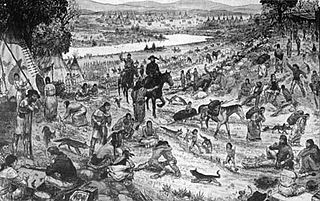 W
WRocky Mountain Rendezvous was an annual gathering (1825–1840) at various locations held by a fur trading company at which trappers and mountain men sold their furs and hides and replenished their supplies. The fur companies assembled teamster-driven mule trains which carried whiskey and supplies to a pre-announced location each spring-summer and set up a trading fair—the rendezvous—and at the season's end, packed furs out, normally the British Companies to Fort Vancouver in the Pacific Northwest, and to one of the northern Missouri River ports such as St. Joseph, Missouri, if an American overland fur trading company.
 W
WGeorge Frederick Ruxton was a British explorer and travel writer. He was a lieutenant in the British Army, received a medal for gallantry from Queen Isabella II of Spain, was a hunter and explorer and published papers and books about his travels to Africa, Canada, Mexico and the United States.
 W
WRufus B. Sage (1817–1893) was an American writer, journalist and later mountain man. He is known as the author of Scenes in the Rocky Mountains published in 1846, depicting the life of fur trappers.
 W
WTom Sharp, a former Confederate soldier and explorer, operated a trading post on the Taos Trail and founded the now extinct town of Malachite, Colorado. It was located on the Huerfano River in Huerfano County, Colorado. He became a nationally known horse and cattle breeder.
 W
WJedediah Strong Smith, was an American clerk, transcontinental pioneer, frontiersman, hunter, trapper, author, cartographer, and explorer of the Rocky Mountains, the North American West, and the Southwest during the early 19th century. After 75 years of obscurity following his death, Smith was rediscovered as the American whose explorations led to the use of the 20-mile (32 km)-wide South Pass as the dominant point of crossing the Continental Divide for pioneers on the Oregon Trail.
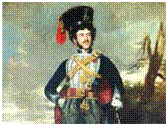 W
WSir William Drummond Stewart, 7th Baronet was a Scottish adventurer and British military officer. He travelled extensively in the American West for nearly seven years in the 1830s. In 1837 he took along the American artist, Alfred Jacob Miller, hiring him to do sketches of the trip. Many of his completed oil paintings of American Indian life and the Rocky Mountains originally hung in Murthly Castle, though they have now been dispersed to a number of private and public collections.
 W
WWilliam Lewis Sublette, also spelled Sublett, was an American frontiersman, trapper, fur trader, explorer, and mountain man. With his four brothers, after 1823 he became an agent of the Rocky Mountain Fur Company. Later he became one of the company's co-owners, exploiting the riches of the Oregon Country. He helped settle and improve the best routes for migrants along the Oregon Trail.
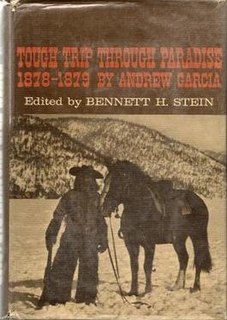 W
WTough Trip Through Paradise 1878-1879 is the autobiography of Andrew Garcia (1853-1943), a man of Hispanic descent who was born in El Paso, but moved north to Montana in 1876 and became a mountain man. He wrote down his story in his later years, but never seriously sought publication due to a combination of disapproval from family members and fear of his story being exploited by dime novelists. The book covers Garcia's time in Montana from 1878 through 1879.
 W
WElbridge Trask also known as Eldridge Trask was an American fur trapper and mountain man in the Oregon Country. Immortalized by a series of modern historical novels by Don Berry, he is best known as an early white settler along Tillamook Bay on the coast of the U.S. state of Oregon. The Trask River and Trask Mountain along the Northern Oregon Coast Range are also named after him.
 W
WJohn Turner was an American fur trapper and guide who first entered Oregon Country in 1828 and became an early resident of the Willamette Valley. Later he moved to California where he was part of the second attempt to rescue the Donner Party.
 W
WJoseph R. Walker was a mountain man and experienced scout. He established the segment of the California Trail, the primary route for the emigrants to the gold fields during the California gold rush, from Fort Hall, Idaho to the Truckee River. The Walker River and Walker Lake in Nevada were named for him by John C. Frémont.
 W
WPauline Weaver, born Powell Weaver, was an American mountain man, trapper, military scout, prospector, and explorer who was active in the early Southwestern United States. A number of geographic features in Arizona are named after him.
 W
WWilliam Sherley "Old Bill" Williams was a noted mountain man and frontiersman. He served as an interpreter for the government, and led several expeditions in the West. Fluent in several languages, he lived with the Osage, where he married the daughter of a chief, and with the Ute.
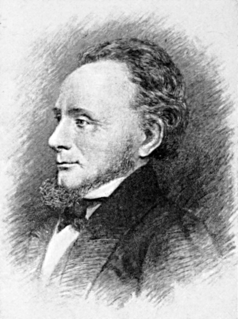 W
WNathaniel Jarvis Wyeth was an American inventor and businessman in Boston, Massachusetts who contributed greatly to its ice industry. Due to his inventions, Boston could harvest and ship ice internationally. In the 1830s, he was also a mountain man who led two expeditions to the Northwest and set up two trading posts, one in present-day Idaho and one in present-day Oregon.
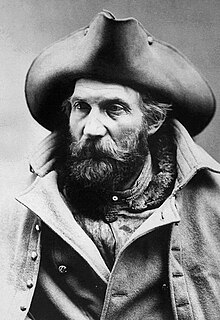 W
WHenry S. Yount was an American Civil War soldier, mountain man, professional hunter and trapper, prospector, wilderness guide and packer, seasonal employee of the United States Department of the Interior, and the first game warden in Yellowstone National Park. He was nicknamed "Rocky Mountain Harry Yount".
 W
W W
W